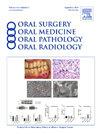Uncovering a rare discovery: a singular account of osteoma in the stylohyoid chain
IF 2
3区 医学
Q2 DENTISTRY, ORAL SURGERY & MEDICINE
Oral Surgery Oral Medicine Oral Pathology Oral Radiology
Pub Date : 2025-02-04
DOI:10.1016/j.oooo.2024.11.043
引用次数: 0
Abstract
Clinical Presentation
A 54-year-old male patient presented to the clinic for a periodic check-up. A panoramic radiograph taken in 2022 showed ossification of the stylohyoid ligament on both sides with an oval radiopacity on the right side. Recent cone beam computed tomography revealed a well-defined, homogenous, and hyperdense entity, arising from the lower third of the ossified stylohyoid ligament on the right side, close to the hyoid bone.
Differential Diagnosis
Osteoma of the stylohyoid chain shares similar morphologic features to Eagle's syndrome and stylohyoid syndrome, demonstrating calcification or ossification of the stylohyoid ligament. Other conditions include epidermal inclusion cyst of the styloid process, osteochondroma of the styloid process, and benign tumors of the hyoid bone, parapharyngeal space, and salivary gland. Osteoma itself is further classified as compact (ivory), spongy (trabecular), or combined, depending on the proliferation of compact or trabecular bone. It can also have three subtypes based on the location: central, peripheral, and extraskeletal.
Diagnosis and Management
Due to the asymptomatic status of this case, the case is being monitored and no surgical intervention is advised at present. General microscopic features of osteoma include mixture of mature, dense lamellar and woven bone patterns. If the osteoma becomes symptomatic, it can be removed by either minimally invasive endoscopy or open surgery. Occasionally, partial resection of the ossified stylohyoid ligament is performed.
Conclusion
Osteoma, a benign tumor commonly found in the long bones of the body, rarely manifests within the neck region. Even more infrequent are tumors originating from the stylohyoid chain, with only a single documented case of osteoma reported in the medical literature back in 1993. This unique case delves into the details of an osteoma that emerged from the stylohyoid chain, marking it as the second recorded occurrence of this peculiar condition.
求助全文
约1分钟内获得全文
求助全文
来源期刊

Oral Surgery Oral Medicine Oral Pathology Oral Radiology
DENTISTRY, ORAL SURGERY & MEDICINE-
CiteScore
3.80
自引率
6.90%
发文量
1217
审稿时长
2-4 weeks
期刊介绍:
Oral Surgery, Oral Medicine, Oral Pathology and Oral Radiology is required reading for anyone in the fields of oral surgery, oral medicine, oral pathology, oral radiology or advanced general practice dentistry. It is the only major dental journal that provides a practical and complete overview of the medical and surgical techniques of dental practice in four areas. Topics covered include such current issues as dental implants, treatment of HIV-infected patients, and evaluation and treatment of TMJ disorders. The official publication for nine societies, the Journal is recommended for initial purchase in the Brandon Hill study, Selected List of Books and Journals for the Small Medical Library.
 求助内容:
求助内容: 应助结果提醒方式:
应助结果提醒方式:


